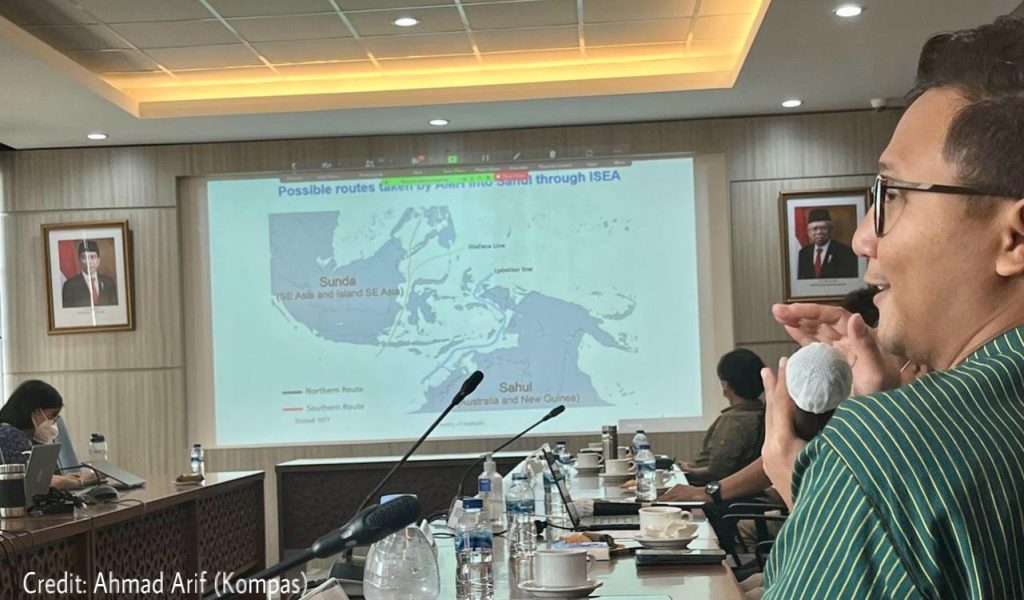Uncovering Indonesia History through Archaeology and Paleogenomics
Paleogenomics is the study
of analysis of genomic information from ancient organism remains. By studying
ancient genomics data, scientists are able to have a better understanding of history.
In terms of human population genetics, paleogenomics could reveal new insight
into human migration, past admixture, and ancient diseases in the past.
However, in tropical countries such as Indonesia, it is rather difficult to
preserve ancient genetic material since the tropical and humid climates tend to
damage archaeological samples and genetic materials within. The role of an
archaeologist is crucial in terms of sample collection for scientists to be
able to perform paleogenomics analysis.
On 2nd August 2022, Mochtar
Riady Institute for Nanotechnology (MRIN), Pusat Riset Arkeologi Prasejarah dan
Sejarah, and Organisasi Riset Arkeologi, Bahasa, dan Sastra of National
Research and Innovation Agency officially entered a collaborative agreement
in Paleogenomic and Archaeological research marked by the signing of MoU. The
first event born from this joint research project is a two days capacity
building of Indonesian researchers and archaeologists in the paleogenomics
field in the form of a seminar and workshop.
The
two days event is a collaboration between MRIN, Pusat Riset Arkeologi
Sejarah dan Prasejarah, and the Australian Centre for Ancient DNA (ACAD), The
University of Adelaide. The Paleogenomic Seminar was held on 2nd August
2022 following the MoU signing ceremony. The first session of the seminar aimed
to familiarise the concept of paleogenomics and its importance to understand
the history of Indonesia to Indonesian researchers and archaeologists. The
first speaker, Prof. dr. Herawati Sudoyo from MRIN, explained the
diversity of Indonesian people from a genetic aspect. Afterward, the second
speaker, Ph.D. Candidate Gludhug A. Purnomo elaborated on the history of
human migration in Indonesia from modern population data. Finally, the third
speaker, Assoc. Prof. Bastien Llamas from ACAD emphasized the power of
ancient DNA to reveal the history of the past.

The
afternoon session of the seminar aimed to disclose the potency of
archaeological and paleogenomics research in Indonesia from archaeologists'
point of view. Ph.D. Candidate Agus A. Oktaviana revealed the
significance of archaeological findings in Gua Harimau, Sumatra to enlighten
the prehistoric culture in Indonesia. While archaeologist Dr. Hasanuddin
from Sulawesi and archaeologist Dr. Zubair Mas’ud from Papua said there
are many potential sites and samples in both Sulawesi and Papua waiting to be
genetically analyzed for paleogenomics study.
The
second day of the event was a workshop about paleogenomics brought by Assoc.
Prof. Bastien Llamas. This workshop aims to teach archaeologists how to handle
archaeological samples so they can be processed for paleogenomics analysis. In
the morning session, Assoc. Prof. Bastien Llamas explained the basic theory of
paleogenomics and ancient DNA and in the afternoon session, he demonstrated how
to take samples from tooth and bone samples for paleogenomics analysis.
Up to date, there is still little to no data about ancient human DNA from Indonesia. Tropical climate, lack of facilities, and human resources limit paleogenomics study in Indonesia. The collaboration between MRIN, Pusat Riset Arkeologi Prasejarah dan Sejarah, and Organisasi Riset Arkeologi, Bahasa, dan Sastra is a first step in developing the paleogenomics field of study in Indonesia.
Media press release:
